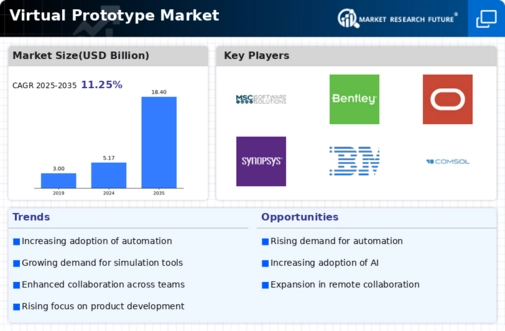Rising Demand for Rapid Prototyping
The Virtual Prototype Market is experiencing a notable surge in demand for rapid prototyping solutions. Companies are increasingly seeking to accelerate their product development cycles, which has led to a greater reliance on virtual prototypes. This trend is particularly evident in sectors such as automotive and aerospace, where the need for quick iterations and testing is paramount. According to recent data, the market for rapid prototyping is projected to grow at a compound annual growth rate of approximately 25% over the next five years. This growth is driven by the need for cost-effective solutions that reduce time-to-market while maintaining high-quality standards. As organizations strive to innovate faster, the Virtual Prototype Market is likely to play a crucial role in facilitating these advancements.
Expansion of Industry 4.0 Initiatives
The ongoing expansion of Industry 4.0 initiatives is significantly impacting the Virtual Prototype Market. As industries embrace digital transformation, the integration of smart technologies and data analytics is becoming commonplace. This shift facilitates the development of virtual prototypes that are not only more efficient but also more aligned with real-time data. Industries such as manufacturing and healthcare are particularly well-positioned to leverage these advancements, as they can optimize their processes and improve product quality. Reports indicate that the adoption of Industry 4.0 technologies could lead to a 15% increase in productivity across various sectors. Thus, the Virtual Prototype Market stands to gain from the broader implementation of these innovative practices.
Growing Investment in Research and Development
Investment in research and development (R&D) is a critical driver for the Virtual Prototype Market. Companies are increasingly allocating resources to R&D to foster innovation and maintain competitive advantages. This trend is particularly evident in technology-driven sectors, where rapid advancements necessitate continuous improvement of products and services. Data suggests that R&D spending in sectors such as automotive and aerospace has increased by over 10% annually, reflecting a commitment to innovation. As organizations prioritize R&D, the demand for virtual prototyping solutions is likely to rise, enabling faster testing and validation of new concepts. Consequently, the Virtual Prototype Market is expected to thrive as companies seek to enhance their R&D capabilities.
Integration of Advanced Simulation Technologies
The integration of advanced simulation technologies is transforming the Virtual Prototype Market. These technologies enable engineers and designers to create highly accurate virtual models that can simulate real-world conditions. This capability is particularly beneficial in industries such as electronics and consumer goods, where product performance is critical. The use of simulation tools can lead to a reduction in physical prototypes, thereby saving costs and resources. Recent studies indicate that companies utilizing advanced simulation technologies can reduce their development costs by up to 30%. As the demand for precision and efficiency continues to rise, the Virtual Prototype Market is expected to expand significantly, driven by the adoption of these innovative simulation solutions.
Increased Focus on Customization and Personalization
Customization and personalization are becoming increasingly important in the Virtual Prototype Market. As consumer preferences evolve, companies are recognizing the need to tailor their products to meet specific customer demands. Virtual prototyping allows for greater flexibility in design, enabling manufacturers to create unique products without the extensive costs associated with traditional prototyping methods. This trend is particularly prominent in the fashion and consumer electronics sectors, where personalized products can enhance customer satisfaction and loyalty. Market analysis suggests that the demand for customized solutions is likely to grow by over 20% in the coming years. Consequently, the Virtual Prototype Market is poised to benefit from this shift towards more individualized offerings.


















Leave a Comment